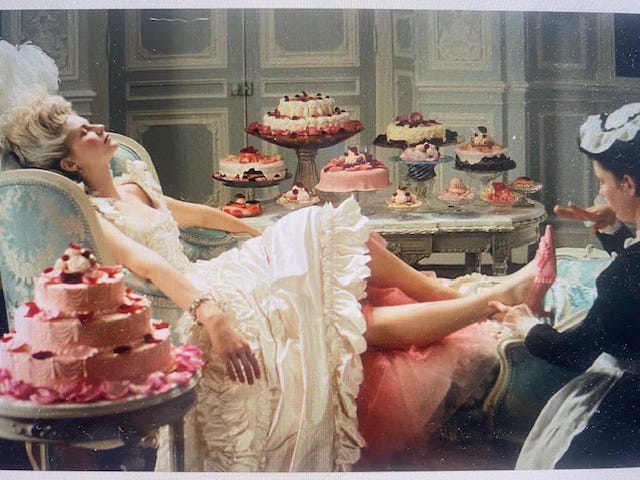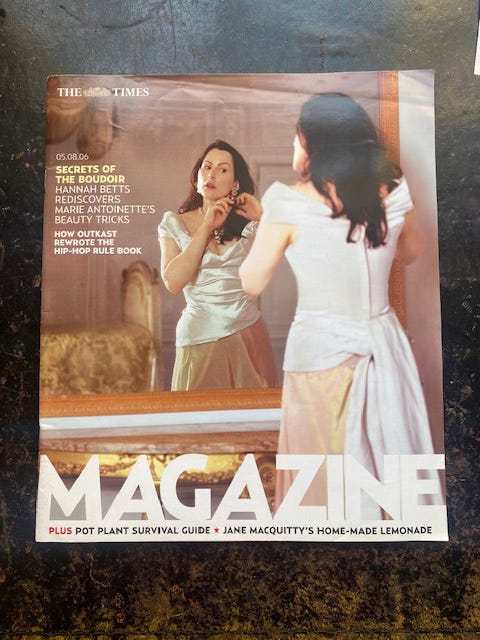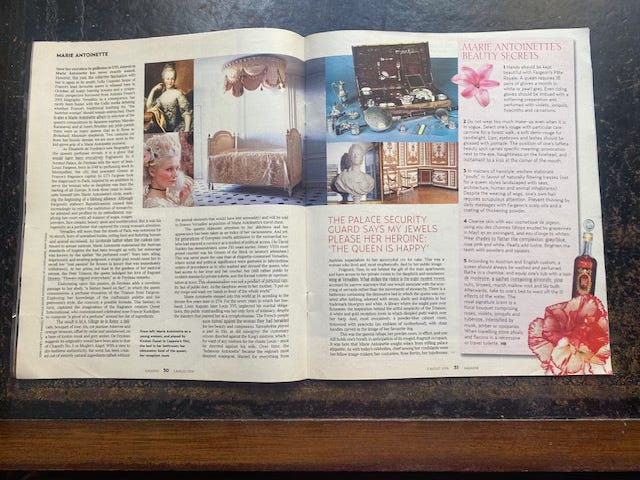You wait years for a Marie Antoinette moment, then two come along at once. First off, we’ve had Versailles: Science and Splendour at London’s Science Museum (closing April 21st). Its star exhibit: the world’s most famous watch, “The Grand Complication,” or Breguet No. 160, created for this much-maligned icon. It was built without a budget, of 823 parts, featuring rubies, sapphires, platinum and gold. Celebrated as “a poem in clockwork,” it took 19 years to complete (by which time the “Infamous Antoinette” was no more).
In other nymphs-and-shepherds devs, the V&A’s hotly-anticipated Marie Antoinette: Style, will open on September 20th, sponsored by Manolo Blahnik. Doubtless, there will be piles of silk slippers, pastel Ladurée pyramids, and attacks of the vapours all round. I once interviewed Kirsten Dunst, star of the sugar-high Coppola biopic. We were meeting years later, two hacks interviewing her about an entirely different project. Yet, all the A-gay alongside me could do was swoon and demand signed, powdered-wig pictures. Eventually, she and I gave up to indulge this besotted courtier.
I once had my own MA experience, described in a Times Magazine piece from [staggers somewhat] - 19 years ago (below). To enable it to be a cover story, it was deemed imperative that I dress up as our heroine. Only problem, (pre-Coppola) Versailles didn’t allow photo shoots. Accordingly, trusty Times photographer John Carey and I smuggled in a vaguely Petit Trianon-style Westwood rig-out plus Haskell bling. Then, during a tour of La Reine’s poignantly miniscule private rooms - not usually revealed to the public - I leapt into a corridor and swapped outfits; concealing my breasts with my hands Carry On-style when confronted by a posse of Japanese tourists.
A reverential palace guard, who sported the initials MA on her breast, informed us that she communicated with her mistress daily. Shining-eyed, she declared that the paste pearls I sported meet with royal approval: “Beautiful, very beautiful. The queen is happy.”
Here’s the piece on MA, her elaborate toilette and “perfumed court”:
Secrets of the Boudoir
With Marie Antoinette once again the focus of our fascination, Hannah Betts goes to Versailles to examine the intimate world of a woman condemned for her extravagant toilette and her “perfumed court”
Saturday, August 05 2006, The Times
Since her execution by guillotine in 1793, interest in Marie Antoinette has never exactly waned. However, this year, the collective fascination with her is again at its zenith. Sofia Coppola’s biopic of France’s least favourite queen is released here in October, all lushly heaving bosoms and a sympathetic perspective borrowed from Antonia Fraser’s 2001 biography. Versailles, as a consequence, has rarely been busier, with the Gallic media debating whether France’s traditional loathing for “the Austrian woman” should remain entrenched.
There is also a Marie Antoinette album (a selection of the queen’s compositions by Japanese soprano Mayuko Karasawa) and at June’s Brazilian gay pride parade there were as many queens clad as la Reine as Brokeback Mountain shepherds. Two centuries on from her bloody demise, we are once more in the kid-glove grip of a Marie Antoinette moment.
As Elisabeth de Feydeau’s new biography of the queen’s perfumer reveals, it is a glove that would have been evocatively fragranced. In A Scented Palace, de Feydeau tells the story of Jean-Louis Fargeon, born in 1748 to perfuming stock in Montpellier, the city that preceded Grasse as France’s fragrance capital. In 1773 Fargeon took the stagecoach to Paris, inspired by an ambition to serve the woman who as dauphine was then the darling of all Europe.
It took three years to insinuate himself into Marie Antoinette’s circle, marking the beginning of a lifelong alliance. Although Fargeon’s stalwart Republicanism caused him increasingly to reject the institution of monarchy, he admired and profited by its embodiment, supplying her court with all manner of soaps, rouges, powders, face creams, beauty spots and toothbrushes. But it was his ingenuity as a perfumer that captured the young woman’s attention.
Versailles, still more than the streets of Paris, was notorious for its stench, born of unwashed bodies, rotting food and festering human and animal excrement. An inveterate bather when the custom continued to arouse mistrust, Marie Antoinette maintained the Austrian standards of hygiene she had been brought up with; her entourage was known by the epithet “the perfumed court”.
Years later, ailing, imprisoned, and awaiting judgment, a simple posy would cause her to recall her “real passion” for flowers (a luxury that was immediately withdrawn). At her prime, not least in the gardens of her pastoral retreat, the Petit Trianon, the queen indulged her love of fragrant blooms. “Flowers reigned everywhere,” as de Feydeau remarks.
Elaborating upon this passion, de Feydeau adds a novelistic passage to her study, “a fantasy based on fact”, in which the queen commissions a perfume evocation of the Trianon from Fargeon. Exploring her knowledge of the craftsman’s palette and his patroness’s style, she concocts a possible formula. This fantasy, in turn, captured the imagination of the fragrance creators Quest International, who commissioned celebrated nose Francis Kurkdjian to compose “a ghost of a perfume” around her list of ingredients.
The result is M.A. Sillage de la Reine, a delicate, bouquet of rose, iris, cut jasmine, tuberose and orange blossom, offset by cedar and sandalwood, on a base of tonkin musk and grey amber. De Feydeau suggests its originality would have been akin to that of Chanel’s No. 5 or Mugler’s Angel. With a view to dix-huitième authenticity, the scent has been created out of entirely natural ingredients (albeit without the animal elements that would have lent sensuality) and will be sold to finance Versailles’ acquisition of Marie Antoinette’s travel chest.
The queen’s elaborate attention to her ablutions and her appearance has been taken as an index of her vacuousness. And yet, for generations of European courts, admission to the monarchal toilette had enjoyed a currency as a symbol of political access. (As David Starkey has demonstrated, some 250 years earlier, Henry VIII’s most prized courtier was his Groom of the Stool, or lavatory attendant.)
This was never more the case than at etiquette-consumed Versailles, where social and political significance were gestured in labyrinthine orders of precedence as to who washed and dressed the queen, who had access to her lever and her coucher, her (still rather public by modern standards) private toilette, and the formal toilette de representation at noon. This obsessionalism was not a product of personal vanity, but of public duty. As the dauphine wrote to her mother, “I put on my rouge and wash my hands in front of the whole world.”
Marie Antoinette stepped into this world at 14, acceding to the throne five years later in 1774. For the seven years in which her husband, Louis Auguste, later Louis XVI, neglected his marital obligations, this public manhandling was her only form of intimacy, despite the slanders that painted her as a nymphomaniac. The French people soon turned against the woman they had heralded for her beauty and compassion.
Xenophobia played a part in this, as did misogyny: the customary venom directed against the King’s mistress, which – for want of any mistress for the chaste Louis – must be directed against his wife. Over time, the “Infamous Antoinette” became the regime’s most despised scapegoat, blamed for everything from Austrian imperialism to her apocryphal cry for cake. This was a woman who lived and, most emphatically, died by her public image.
Poignant, then, to see behind the gilt of the state apartments and have access to her private rooms in the dauphin’s and mesdames’ wing at Versailles…









